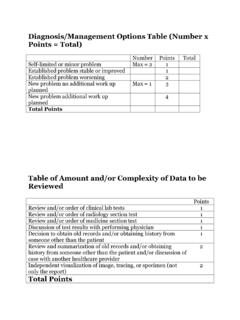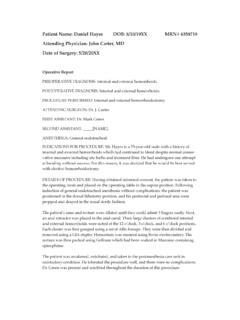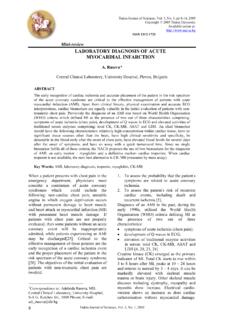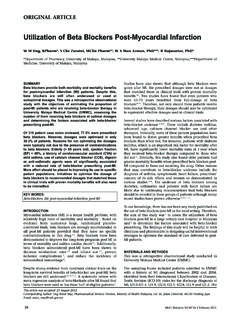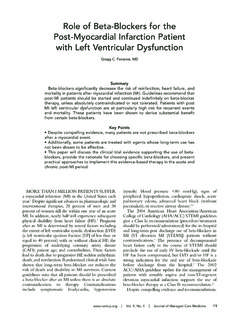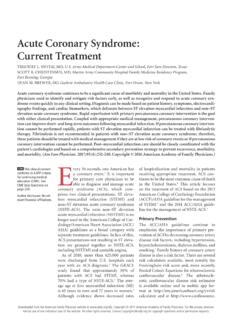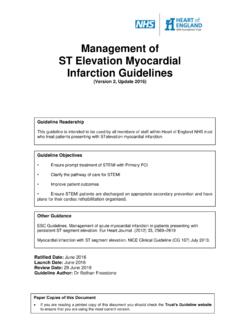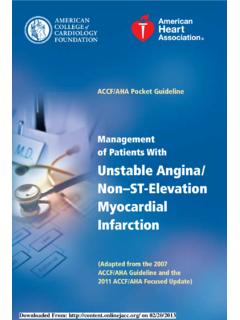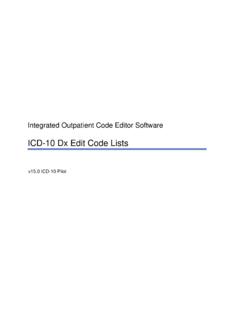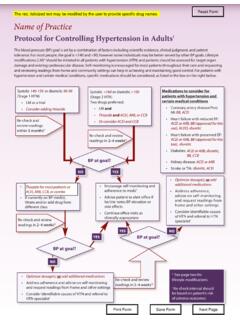Transcription of Long term care coding issues for ICD-10-CM
1 long term care coding issues for ICD-10-CM coding Clinic, Fourth Quarter 2012 Pages: 90-98 Effective with discharges: October 1, 2012 Related Information long Term care coding issues for ICD-10-CM coding guidelines and examples were provided in coding Clinic for ICD-9- CM, Fourth Quarter 1999 with regards to the application of coding guidelines for long term care (LTC). Similarly, inquiries have been received regarding how coders should sequence the principal diagnosis when coding in the long term care (LTC) setting. The following have been developed and approved by the Cooperating Parties in conjunction with the Editorial Advisory Board of coding Clinic, to standardize the process of data collection for LTC and to assist the coder in coding and reporting these cases using ICD-10-CM .
2 The diagnostic listing in long term care (LTC) is dynamic and dependent on many factors and has a longer time frame than an acute care stay. ICD-10- CM codes are assigned upon admission, concurrently as diagnoses arise, at the time of discharge, transfer, or expiration of the resident. The UHDDS definition of principal diagnosis (that condition established after study to be chiefly responsible for occasioning the admission of the patient to the hospital for care ) has been expanded since its initial development and now includes all non-outpatient settings (acute care , short term, long term care and psychiatric hospitals; home health agencies; rehab facilities; nursing homes, etc).
3 Other diagnoses present ( , chronic conditions), which affect the resident s continued care , should also be coded. The listing of diagnoses in the long -term care setting, may vary depending on the point in time when coding is being done. The first listed diagnosis is the diagnosis which is chiefly responsible for the admission to, or continued residence in the nursing facility and should be sequenced first. For example, when coding an admission to the facility, the first listed diagnosis is the condition chiefly responsible for the admission to the facility. If coding diagnoses during the resident s stay, it is the condition chiefly responsible for the continued stay in the facility.
4 Question: A patient is discharged from the hospital and admitted to a long -term care facility (LTC) with a diagnosis of acute cerebral infarction with left-sided hemiparesis and dysphasia. The diagnosis on admission to the LTC is documented as acute CVA. What is the appropriate code assignment to describe this patient s condition? Answer: Assign code , Hemiplegia and hemiparesis following cerebral infarction affecting left nondominant side, and code , Dysphasia following cerebral infarction, to completely describe the patient s condition. The hemiparesis and dysphasia are considered sequelae of the acute CVA for this LTC admission. coding guidelines state that these late effects include neurologic deficits that persist after initial onset of conditions classifiable to categories I60-I67.
5 Codes from I60- I67 are reserved for the initial (first) episode of care for the acute cerebrovascular disease. Please refer to the 2013 edition of the coding guidelines for guidance as to the use of dominant/nondominant side for codes from category I69. Question: Does the medical documentation have to state old CVA in order to use the sequelae (I69) codes for the LTC admission? Answer: No, there is no time limit on when a late effect code may be used since the neurologic deficit caused by cerebrovascular disease may be present from the onset or may arise at any time after the onset of the condition classifiable to I60-I67. When the patient is admitted to long term care (LTC) following treatment of an acute CVA, a code from subcategory , Sequelae of cerebral infarction, is assigned for the LTC admission.
6 Question: A patient is admitted to the LTC facility following treatment of an acute CVA. The patient made a complete recovery from the CVA. She was diagnosed with progressive senile dementia, coronary artery disease and congestive heart failure. Because of her deteriorating physical status and chronic medical conditions, she was admitted into a long -term care facility. How would you code and sequence these diagnoses? Answer: Any of the chronic medical conditions may be sequenced as the first-listed diagnosis. Therefore, assign codes , Unspecified dementia without behavioral disturbance, , Heart failure, unspecified, and , Atherosclerotic heart disease of native coronary artery without angina pectoris.
7 A code from category I69, Sequelae of cerebrovascular disease, is inappropriate, because there are no residuals from the CVA. Code , Personal history of transient ischemic attack (TIA), and cerebral infarction without residual deficits, may be assigned as an additional diagnosis, toidentify the history of CVA. Question: The patient is transferred to LTC for physical therapy following a hospitalization for treatment of an acute pelvic and clavicular fracture. How should the LTC stay be coded? Answer: When a patient is admitted to the LTC specifically for rehabilitative physical therapy following an injury, assign the acute injury code with the appropriate 7th character (for subsequent encounter), as the firstlisted diagnosis.
8 In this example, assign code , Fracture of unspecified parts of lumbosacral spine and pelvis, subsequent encounter for fracture with routine healing, or , Fracture of unspecified part of unspecified clavicle, subsequent encounter for fracture with routine healing, as the reason for the admission. Assign the appropriate procedure code to show that the physical therapy was provided. It is inappropriate to assign aftercare Z codes for aftercare for traumatic fractures in ICD-10-CM . Refer to Section , of the Official Guidelines for coding and Reporting for the Application of 7th characters for Chapter 19. Question: A patient is admitted to LTC following hospital treatment of a fracture of the right femur.
9 The reason for the LTC admission is to allow the patient to regain strength and the fracture to heal. What code is used to describe the LTC admission? Answer: Assign code , Unspecified fracture of right femur, subsequent encounter for closed fracture with routine healing, as the principal diagnosis. The 7th character D is used for encounters after the patient has received active treatment for the condition and is now receiving routine care during the healing or recovery phase. Code any other coexistent conditions that require treatment. Do not assign an aftercare Z code. Question: A resident in LTC facility develops a urinary tract infection (UTI), which is treated and resolved during the LTC stay.
10 Should the UTI be coded? Answer: Assign code , Urinary tract infection, site not specified. The diagnosis would be part of the resident s active problem list until the infection is resolved, at which time it would no longer be coded and reported. Question: A resident returns to the LTC facility following hospital care for pneumonia. The physician s orders state, continue IV antibiotics for 3 days, after which time the resident is to have a repeat x-ray to determine status of the pneumonia. Would you code the pneumonia? Answer: Yes, the pneumonia should be coded. If the physician does not identify a causal organism ( , staph, strep, pseudomonas, etc.)






